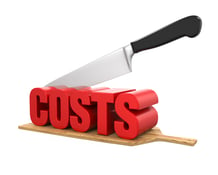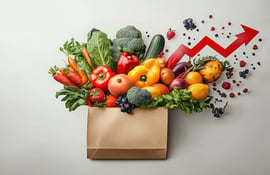The how-to discussions of menu design too often have a seedy, ick-factor that makes you feel like you are trying to swindle people. As you consider how to design (or overhaul) your menu, it's short-sighted to focus on any supposed gains you’ll derive from cleverly arranging your items in hopes their order alone slyly upsells your customer.
The reality is, if a person is going to order the cheapest thing on the menu, it doesn’t matter where it’s placed. If they’re in your dining room for their 15th wedding anniversary, their first concern is going to be on the quality of the experience, not the price. If they’re there to grab a sandwich on their 35-minute lunch break on a random Tuesday, their first concern is the quality of the experience, not the price.
People know they’re going to have to spend some money. What they don’t know, until you start taking care of them, is whether it’s going to be worth it. A good menu should start that process. It’s your first line of sales in every dining experience. It should be welcoming, straightforward, and friendly. Most restaurants today disclose prices in an upfront way — this is a transaction, after all — but they tend to omit that itchy dollar sign, to make it feel less about the money. Little touches inform good design, because design is moody. It’s hard to tap out commandments about design choices. There are things to think about and consider, but ultimately, you have a gut and you’ll have to go with it.
Customers also go with their gut, so meet them there. Your menu can have a bit of art to it (figuratively, anyway). Menus signal to diners what to value and how to dine. They also tell them what you love. There’s no single right way to present them. But maybe if we can’t tap out ironclad commandments, we can at least offer some pointers.
Your menu should accomplish a few goals, but subtly
These are your objectives: inform the guest about the available food and beverage options, show prices, and where useful, give a sense of ingredients and preparations. When I spoke with Vicki Rees-Jones, a professional designer whose shop Hyphen Creative Services works with restaurant clients, she emphasized that the best menus tend to have sparse design. Keeping a menu simple will save your guests from the sense of cosmic overwhelm that slows many a fine dinner date to a flat-tired crawl. A menu with too many things to say can be draining. Yes, you can read. But no, perhaps this was not how you expected to have to use your brain at this particular moment.
Like fantastic service, the best menus are effortless. They don’t draw attention to themselves as the thing.
So, where to start? If you can’t afford to hire a design pro, grab some free design tools and keep it simple. Black and white, small to large. Keep in mind your menu does some of the work of the staff, and thus, should complement your staff’s strengths. Are they order-takers for a menu that presents all the details? Then get a little detailed with your descriptions. On the other end, maybe you’ve hired a front of house full of excitable culinary school grads. If so, let them do their thing. Don’t burden the menu with flowery descriptions if the server will be breaking down the differences between an apple and a quince.
In all likelihood your servers fall somewhere in the middle, and your menu should, too.
Menu design will guide your customer’s experience
There’s a lot of advice out there about beguiling people into thinking expensive things are well-priced, but a professional designer will tell you the more important psychology makes people feel like they are going to get what they want. This goes for restaurants at all price points. How do you want to be perceived? Upscale? Kitschy? Retro? Do you want people to share small plates and order entrees? Is the whole meal best enjoyed family style? Your menu is where you start to cue your guests toward their best night out.
Menus, like fashion, change stylistically often. A well-designed, classic menu has the longevity of a tailored wool coat. The menu at Michael’s Genuine in Miami has the same layout as when they opened in 2007. The entire restaurant has been redesigned and renovated, but the format of the menu is perennial. It’s an excellent example of subtly directing your eyes and allowing you to navigate and design your dining experience.
In the West, Rees-Jones says, our eye patterns tend to flow left to right, top to bottom. Menus are expected to respect, if not conform to, this prevailing logic. Depending on your offerings, the easiest flow will be chronologically from apps to mids to entrees to desserts. If you serve snacks or large-format dishes you may also sort by size. Finding the format that fits your space can take some tinkering, and here’s where I plug a professional: get a designer. You can find oodles of designers on gig platforms such as Behance or Upwork by searching for menu design. In any event, professional designers are dialed into the many subconscious design elements most people take for granted. They can help you optimize and simplify while maintaining the aesthetic.
Sometimes design elements are small, nuanced. Sometimes they are neon signs. You can highlight your strengths with brackets or boxes. Are you the undisputed spare rib master for 300 miles in all directions? Put baby in a box and help us find her. Use the same strategy to push things you know are great but which maybe haven't caught on. Giving the description a little extra love subconsciously signals importance. So if you know your duck is reinventing the wheel but no one else seems to realize, highlight it! Tell the story.
Your restaurant has taste, so let your menu reflect it
People are going to love and loathe things for personal reasons. Take QR codes. They’re easy, they’re sanitary, they’re sustainable. You can take things off the menu on the fly and you don’t have to print anything and realize there’s a typo and print it again and have the chef change their mind and print it again.
But some people find them galling. Maybe they miss having a potential keepsake in their hands. Maybe the timeline of adoption conjures up Covid-y feelings. Maybe the feel of paper makes them nostalgic. Maybe 75 other things that they think of that you won’t. Quite likely they’ve never had to print menus. And that’s OK. You might find a happy medium in offering QR codes and having one or two paper menus handy for people who forgot their phones before leaving the house, or who claim they did, at least.
You’re going to try a few things. Some will work. Others won’t, for reasons as frivolous as these. But don’t let the fear of failure coax you into designing your menu with no more joy than an actuary’s resume. Aesthetics are subjective. Ultimately you should trust in yours. Just make sure you’re also getting the job done.
[Photo by Roman Odintsov via Pexels]





